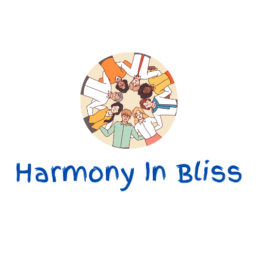
June is a special month for many people around the world as it marks the celebration of Pride Month, a time dedicated to honoring the LGBTQ+ community and their struggles for equality.
Celebrated every year in June, Pride Month commemorates the Stonewall Riots of 1969, a pivotal moment in the fight for LGBTQ+ rights. This month is not just about colorful parades and festivals; it’s a reminder of the ongoing struggle for acceptance and the progress that has been made.
It’s a time to educate, celebrate, and show solidarity. Let’s take a look at the significance of Pride Month, its rich history, and how you can join in the celebration.
Table of Contents
When Is Pride Month Celebrated?
Pride Month is celebrated annually in June. This tradition began to honor the Stonewall Riots, which occurred at the end of June 1969. Throughout the month, numerous events are held worldwide to recognize the impact that LGBTQ+ individuals have had on history.
It’s a time to celebrate love, identity, and the strides made toward equality and to acknowledge the work still to be done.
History Of Pride Month
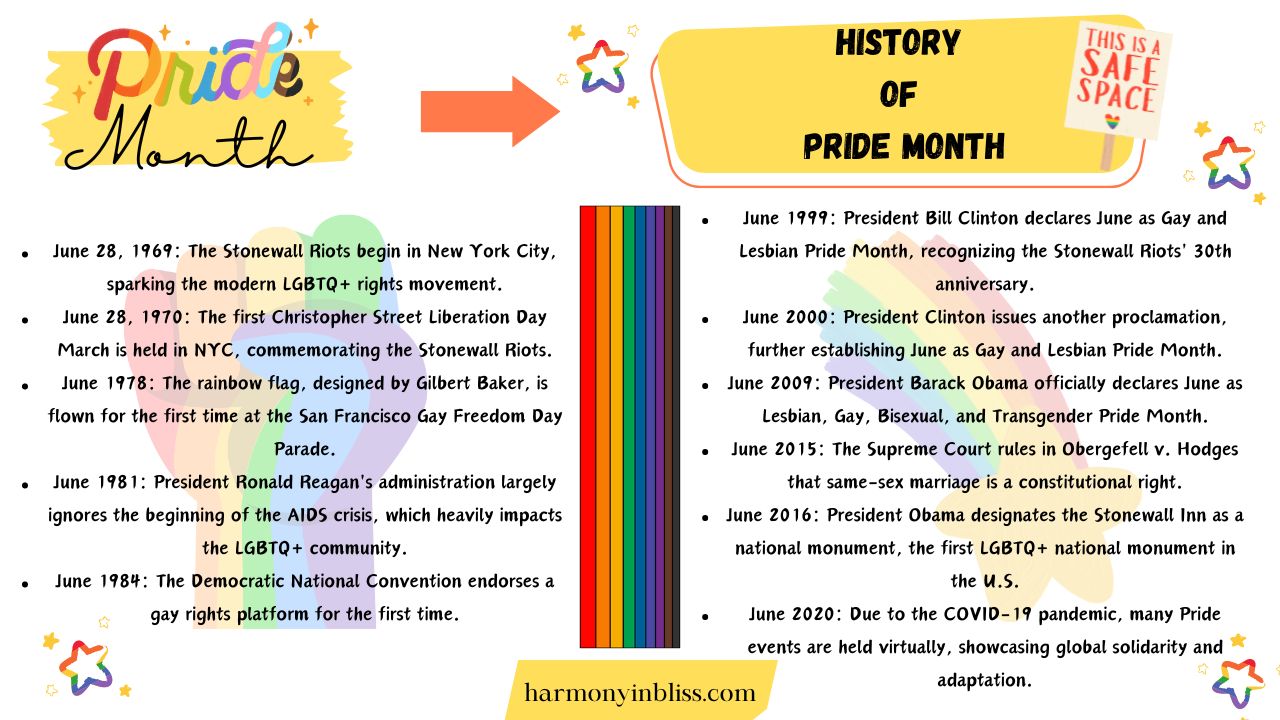
Pride Month has a rich history that is deeply intertwined with the LGBTQ+ rights movement. Pride Month is rooted in the struggle for LGBTQ+ rights, which gained significant momentum following the Stonewall Riots.
This event catalyzed the modern LGBTQ+ liberation movement, leading to the annual Pride celebrations we know today.
June 28, 1969:
The Stonewall Riots begin at the Stonewall Inn in New York City, following a police raid. The riots last several days, marking a significant turning point in the LGBTQ+ rights movement.
1970:
The first Pride marches are held in New York City, Los Angeles, and Chicago on the anniversary of the Stonewall Riots, marking the beginning of annual Pride events.
1978:
The rainbow flag, designed by artist Gilbert Baker, is first flown at the San Francisco Gay Freedom Day Parade. It becomes a symbol of LGBTQ+ pride and diversity.
1980s:
The AIDS crisis hits the LGBTQ+ community hard, leading to increased activism and visibility. Pride events begin to incorporate AIDS awareness and advocacy.
1999:
President Bill Clinton officially declares June as Gay and Lesbian Pride Month in the United States.
2000s:
Pride events grow globally, with many countries adopting June as their official Pride Month.
2009:
President Barack Obama expands the declaration to include the entire LGBTQ+ community, calling it Lesbian, Gay, Bisexual, and Transgender Pride Month.
2015:
The U.S. Supreme Court legalizes same-sex marriage nationwide, a significant milestone celebrated during Pride Month.
2020s:
Pride Month continues to evolve, addressing issues like transgender rights, racial justice within the LGBTQ+ community, and intersectionality.
How To Celebrate Pride Month
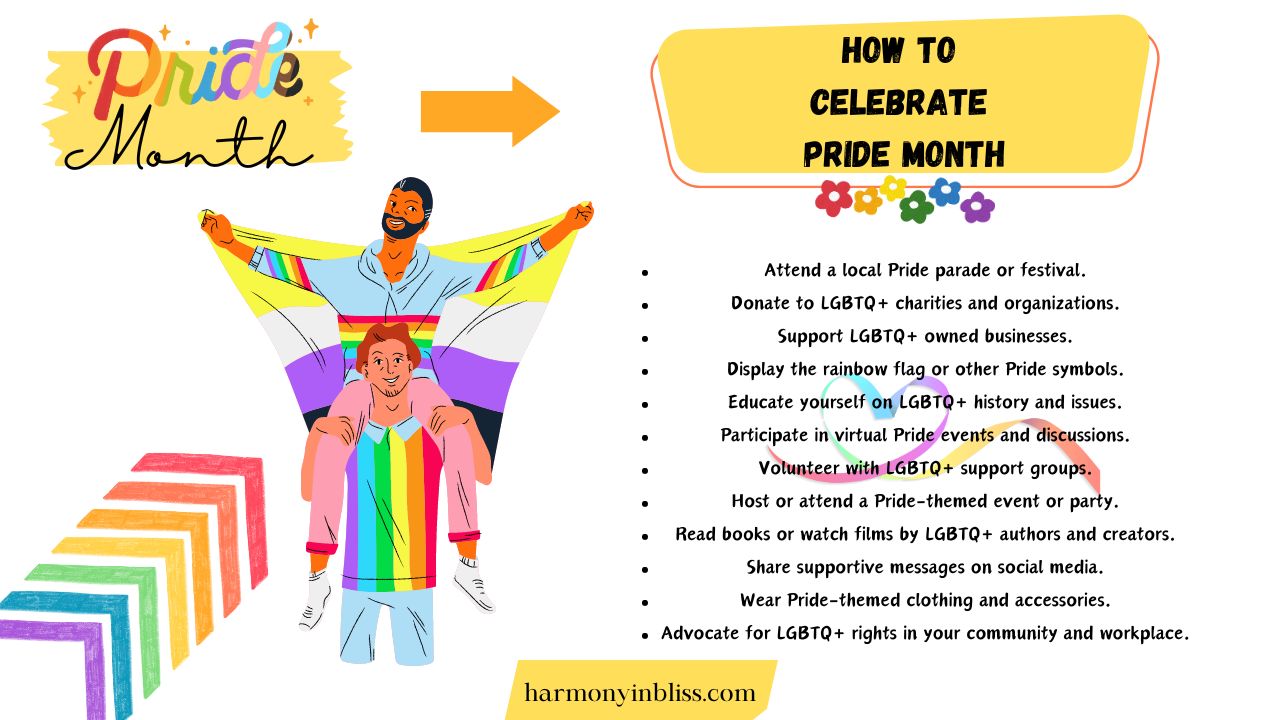
Attend a Pride Parade:
Experience the vibrant parades filled with floats, music, and marchers celebrating LGBTQ+ pride and culture.
These parades often feature speeches, performances, and a sense of community that can be both uplifting and empowering. Check your local listings for events in your area.
Educate Yourself:
Read books, watch documentaries, and learn about LGBTQ+ history and issues to deepen your understanding and support.
There are many resources available that cover topics from the history of the movement to personal stories from LGBTQ+ individuals. Knowledge is a powerful tool in promoting acceptance and equality.
Support LGBTQ+ Businesses:
Show your support by shopping at businesses owned by LGBTQ+ individuals and supporting queer artists and creators.
This not only helps sustain these businesses but also promotes a diverse and inclusive economy. Look for directories and lists of LGBTQ+-owned businesses online.
Volunteer:
Offer your time to organizations that support LGBTQ+ rights and welfare. Many nonprofits rely on volunteers to help with events, advocacy, and day-to-day operations.
Volunteering is a hands-on way to make a difference and support the community directly.
Host an Event:
Organize a small gathering, workshop, or discussion group to spread awareness and celebrate.
This could be a movie night featuring LGBTQ+ films, a book club focusing on queer literature, or a panel discussion with local LGBTQ+ activists. Creating a space for conversation and education can have a lasting impact.
Display the Rainbow Flag:
Show your support by flying the rainbow flag at your home, business, or on social media. The flag is a symbol of pride and solidarity, and displaying it can signal your support for the LGBTQ+ community.
You can also use other symbols like the trans pride flag or the bisexual pride flag.
Advocate for Change:
Use your voice to advocate for LGBTQ+ rights and policies that promote equality and inclusion.
This can involve contacting your elected officials, participating in rallies, or using social media to raise awareness. Advocacy helps push for legislative and social changes that benefit the community.
Donate:
Contribute to LGBTQ+ charities and organizations working towards equality and support services.
Financial support can help these organizations continue their essential work, from providing crisis intervention to lobbying for legal protections. Look for reputable charities that align with your values.
Join Online Events:
Participate in virtual Pride events, webinars, and social media campaigns. These events can include online workshops, virtual parades, and live-streamed performances.
Online participation makes it easier for people from all over the world to join in the celebrations and learn from each other.
Celebrate at Work:
Encourage your workplace to recognize Pride Month with events, education, and inclusive policies.
This could involve organizing lunch-and-learn sessions, setting up diversity training, or hosting social events. A supportive work environment can make a significant difference in the lives of LGBTQ+ employees.
Facts About Pride Month
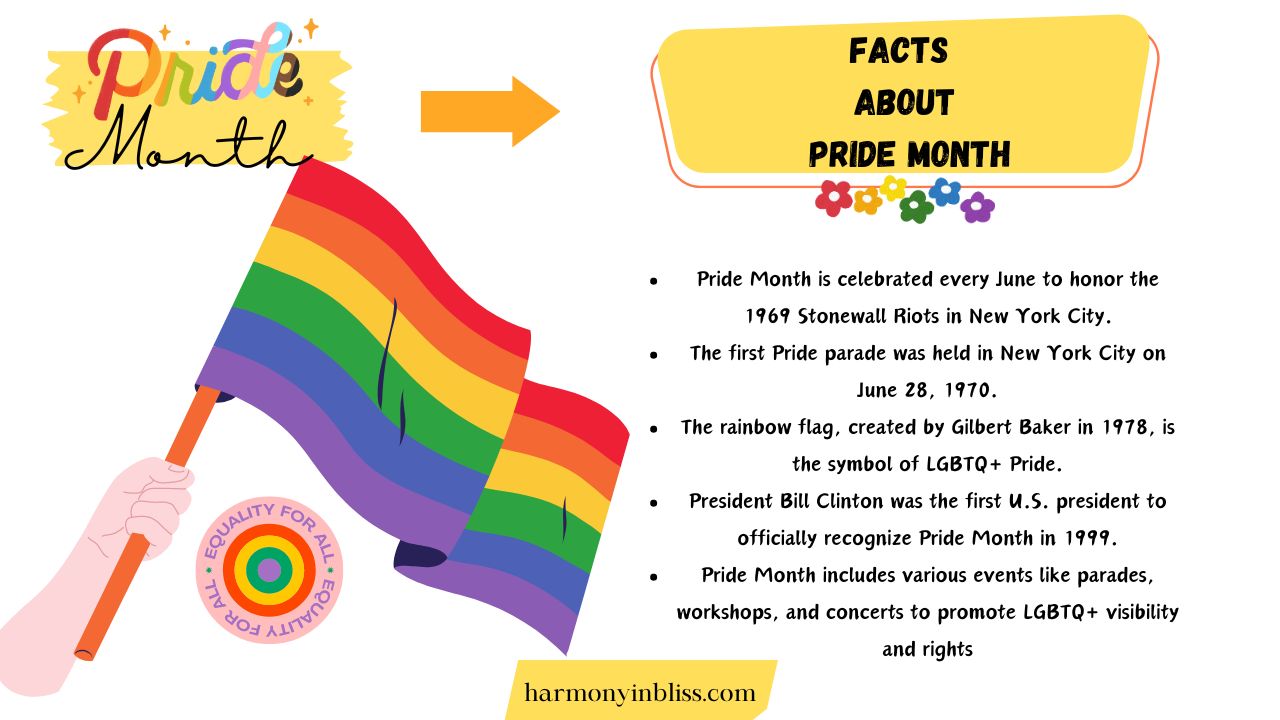
- Pride Month is celebrated in June to honor the Stonewall Riots.
- The first Pride parade was held in 1970, one year after the Stonewall Riots.
- The rainbow flag was first created in 1978 by artist Gilbert Baker.
- In 1999, President Bill Clinton declared June as Gay and Lesbian Pride Month.
- Over 150 cities worldwide now hold annual Pride parades and events.
- Pride parades often feature floats, music, dancing, and colorful costumes.
- The pink triangle, originally used to mark LGBTQ+ individuals in Nazi camps, has been reclaimed as a symbol of pride.
- Many Pride events also focus on raising awareness and funds for LGBTQ+ issues like healthcare and legal rights.
- Pride Month is celebrated in countries across all continents, from the U.S. to South Africa to Japan.
- Many major corporations now participate in Pride Month by sponsoring events and showing their support.
Also Read- Cinco De Mayo
Why Do We Love Pride Month
Celebration of Diversity:
Pride Month celebrates the rich diversity within the LGBTQ+ community, highlighting various identities and experiences.
It’s a time when people from all walks of life come together to honor their uniqueness and find common ground. This celebration fosters a deeper appreciation for different perspectives and ways of life.
Increased Visibility:
It brings LGBTQ+ issues to the forefront, raising awareness and fostering acceptance. Visibility is crucial for breaking down stereotypes and misconceptions about the LGBTQ+ community.
Through media coverage, events, and personal stories, Pride Month helps educate the public and promote understanding.
Sense of Community:
Pride events create a sense of belonging and solidarity among LGBTQ+ individuals and allies. These gatherings offer a supportive environment where people can connect, share their stories, and feel accepted.
The sense of community can be incredibly empowering, especially for those who may feel isolated or marginalized.
Progress and Hope:
Pride Month reflects the progress made in LGBTQ+ rights and inspires hope for continued advancement.
Celebrating milestones like marriage equality and anti-discrimination laws reminds us of the strides that have been made. It also motivates us to keep pushing for further improvements and justice for all.
Expression of Love:
It provides a platform for people to openly express their love and identity without fear. Whether it’s through public displays of affection, wearing pride-themed attire, or sharing their stories, Pride Month encourages people to be their authentic selves.
This freedom of expression is a powerful statement against prejudice and discrimination.
Upcoming Dates of Pride Month for the Next 5 Years
| Year | Dates |
| 2024 | June 1 – June 30 |
| 2025 | June 1 – June 30 |
| 2026 | June 1 – June 30 |
| 2027 | June 1 – June 30 |
| 2028 | June 1 – June 30 |
Pride Month Quotes
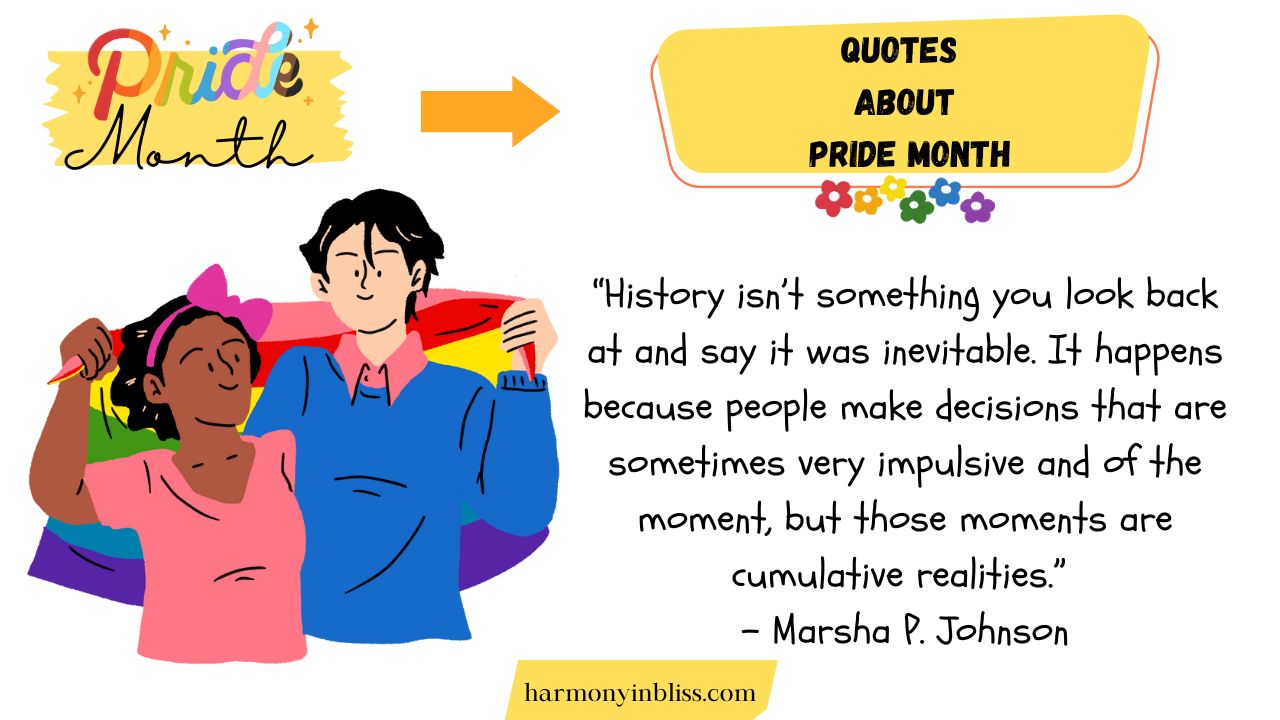
“Love is love.” – Anonymous
“We are here, we are queer, get used to it.” – Anonymous
“The beauty of standing up for your rights is others see you standing and stand up as well.” – Cassandra Duffy
“Equality means more than passing laws. The struggle is really won in the hearts and minds of the community, where it really counts.” – Barbara Gittings
“Openness may not completely disarm prejudice, but it’s a good place to start.” – Jason Collins
“The only queer people are those who don’t love anybody.” – Rita Mae Brown
“No pride for some of us without liberation for all of us.” – Marsha P. Johnson
“It takes no compromise to give people their rights.” – Harvey Milk
“To be yourself in a world that is constantly trying to make you something else is the greatest accomplishment.” – Ralph Waldo Emerson
“Be who you are and say what you feel, because those who mind don’t matter, and those who matter don’t mind.” – Dr. Seuss
“Pride is not the opposite of shame, but its source. True humility is the only antidote to shame.” – Uncle Iroh
“History isn’t something you look back at and say it was inevitable. It happens because people make decisions that are sometimes very impulsive and of the moment, but those moments are cumulative realities.” – Marsha P. Johnson
“You don’t have to be gay to be a supporter—you just have to be human.” – Daniel Radcliffe
“I am a strong, black, lesbian woman. Every single time I say it, I feel so much better.” – Brittney Griner
“Being gay is like glitter, it never goes away.” – Lady Gaga
“Love always wins.” – Anonymous
“I am what I am.” – Anonymous
“You don’t have to be gay to be a supporter—you just have to be human.” – Anonymous
“We should indeed keep calm in the face of difference, and live our lives in a state of inclusion and wonder at the diversity of humanity.” – George Takei
“Stand up for what you believe in, even if it means standing alone.” – Anonymous
“We are not what other people say we are. We are who we know ourselves to be, and we are what we love.” – Laverne Cox
“Gay rights are human rights.” – Hillary Clinton
“What’s the point of being alive if you don’t at least try to do something remarkable?” – Anonymous
“Love is never wrong.” – Melissa Etheridge
“Pride is for everyone.” – Anonymous
“We are powerful because we have survived.” – Audre Lorde
“There’s nothing wrong with you. There’s a lot wrong with the world you live in.” – Chris Colfer
“If you are not personally free to be yourself in that most important of all human activities—the expression of love—then life itself loses its meaning.” – Harvey Milk
“Don’t ever let anyone make you feel like you don’t matter.” – Michelle Obama
“We deserve to experience love fully, equally, without shame and without compromise.” – Elliot Page
Final Words
Pride Month is a powerful reminder of the importance of equality, acceptance, and love for all. It’s a time to celebrate the progress made, acknowledge the work that still needs to be done, and stand in solidarity with the LGBTQ+ community.
By participating in Pride Month activities, educating ourselves, and supporting the rights of all individuals, we can help build a more inclusive and loving world.
Let’s honor the spirit of Pride not just in June, but every day, as we continue to advocate for a future where everyone can live their truth freely and proudly.
